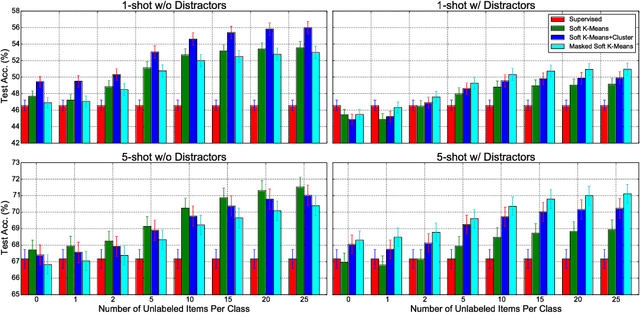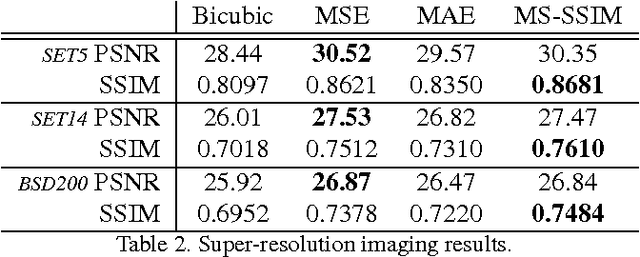Jake Snell
Using Contrastive Learning with Generative Similarity to Learn Spaces that Capture Human Inductive Biases
May 29, 2024



Abstract:Humans rely on strong inductive biases to learn from few examples and abstract useful information from sensory data. Instilling such biases in machine learning models has been shown to improve their performance on various benchmarks including few-shot learning, robustness, and alignment. However, finding effective training procedures to achieve that goal can be challenging as psychologically-rich training data such as human similarity judgments are expensive to scale, and Bayesian models of human inductive biases are often intractable for complex, realistic domains. Here, we address this challenge by introducing a Bayesian notion of generative similarity whereby two datapoints are considered similar if they are likely to have been sampled from the same distribution. This measure can be applied to complex generative processes, including probabilistic programs. We show that generative similarity can be used to define a contrastive learning objective even when its exact form is intractable, enabling learning of spatial embeddings that express specific inductive biases. We demonstrate the utility of our approach by showing how it can be used to capture human inductive biases for geometric shapes, and to better distinguish different abstract drawing styles that are parameterized by probabilistic programs.
Flexible Few-Shot Learning with Contextual Similarity
Dec 10, 2020



Abstract:Existing approaches to few-shot learning deal with tasks that have persistent, rigid notions of classes. Typically, the learner observes data only from a fixed number of classes at training time and is asked to generalize to a new set of classes at test time. Two examples from the same class would always be assigned the same labels in any episode. In this work, we consider a realistic setting where the similarities between examples can change from episode to episode depending on the task context, which is not given to the learner. We define new benchmark datasets for this flexible few-shot scenario, where the tasks are based on images of faces (Celeb-A), shoes (Zappos50K), and general objects (ImageNet-with-Attributes). While classification baselines and episodic approaches learn representations that work well for standard few-shot learning, they suffer in our flexible tasks as novel similarity definitions arise during testing. We propose to build upon recent contrastive unsupervised learning techniques and use a combination of instance and class invariance learning, aiming to obtain general and flexible features. We find that our approach performs strongly on our new flexible few-shot learning benchmarks, demonstrating that unsupervised learning obtains more generalizable representations.
Bayesian Few-Shot Classification with One-vs-Each Pólya-Gamma Augmented Gaussian Processes
Jul 20, 2020



Abstract:Few-shot classification (FSC), the task of adapting a classifier to unseen classes given a small labeled dataset, is an important step on the path toward human-like machine learning. Bayesian methods are well-suited to tackling the fundamental issue of overfitting in the few-shot scenario because they allow practitioners to specify prior beliefs and update those beliefs in light of observed data. Contemporary approaches to Bayesian few-shot classification maintain a posterior distribution over model parameters, which is slow and requires storage that scales with model size. Instead, we propose a Gaussian process classifier based on a novel combination of P\'olya-gamma augmentation and the one-vs-each softmax approximation that allows us to efficiently marginalize over functions rather than model parameters. We demonstrate improved accuracy and uncertainty quantification on both standard few-shot classification benchmarks and few-shot domain transfer tasks.
Learning Latent Subspaces in Variational Autoencoders
Dec 14, 2018



Abstract:Variational autoencoders (VAEs) are widely used deep generative models capable of learning unsupervised latent representations of data. Such representations are often difficult to interpret or control. We consider the problem of unsupervised learning of features correlated to specific labels in a dataset. We propose a VAE-based generative model which we show is capable of extracting features correlated to binary labels in the data and structuring it in a latent subspace which is easy to interpret. Our model, the Conditional Subspace VAE (CSVAE), uses mutual information minimization to learn a low-dimensional latent subspace associated with each label that can easily be inspected and independently manipulated. We demonstrate the utility of the learned representations for attribute manipulation tasks on both the Toronto Face and CelebA datasets.
Meta-Learning for Semi-Supervised Few-Shot Classification
Mar 02, 2018



Abstract:In few-shot classification, we are interested in learning algorithms that train a classifier from only a handful of labeled examples. Recent progress in few-shot classification has featured meta-learning, in which a parameterized model for a learning algorithm is defined and trained on episodes representing different classification problems, each with a small labeled training set and its corresponding test set. In this work, we advance this few-shot classification paradigm towards a scenario where unlabeled examples are also available within each episode. We consider two situations: one where all unlabeled examples are assumed to belong to the same set of classes as the labeled examples of the episode, as well as the more challenging situation where examples from other distractor classes are also provided. To address this paradigm, we propose novel extensions of Prototypical Networks (Snell et al., 2017) that are augmented with the ability to use unlabeled examples when producing prototypes. These models are trained in an end-to-end way on episodes, to learn to leverage the unlabeled examples successfully. We evaluate these methods on versions of the Omniglot and miniImageNet benchmarks, adapted to this new framework augmented with unlabeled examples. We also propose a new split of ImageNet, consisting of a large set of classes, with a hierarchical structure. Our experiments confirm that our Prototypical Networks can learn to improve their predictions due to unlabeled examples, much like a semi-supervised algorithm would.
Prototypical Networks for Few-shot Learning
Jun 19, 2017



Abstract:We propose prototypical networks for the problem of few-shot classification, where a classifier must generalize to new classes not seen in the training set, given only a small number of examples of each new class. Prototypical networks learn a metric space in which classification can be performed by computing distances to prototype representations of each class. Compared to recent approaches for few-shot learning, they reflect a simpler inductive bias that is beneficial in this limited-data regime, and achieve excellent results. We provide an analysis showing that some simple design decisions can yield substantial improvements over recent approaches involving complicated architectural choices and meta-learning. We further extend prototypical networks to zero-shot learning and achieve state-of-the-art results on the CU-Birds dataset.
Learning to Generate Images with Perceptual Similarity Metrics
Jan 24, 2017



Abstract:Deep networks are increasingly being applied to problems involving image synthesis, e.g., generating images from textual descriptions and reconstructing an input image from a compact representation. Supervised training of image-synthesis networks typically uses a pixel-wise loss (PL) to indicate the mismatch between a generated image and its corresponding target image. We propose instead to use a loss function that is better calibrated to human perceptual judgments of image quality: the multiscale structural-similarity score (MS-SSIM). Because MS-SSIM is differentiable, it is easily incorporated into gradient-descent learning. We compare the consequences of using MS-SSIM versus PL loss on training deterministic and stochastic autoencoders. For three different architectures, we collected human judgments of the quality of image reconstructions. Observers reliably prefer images synthesized by MS-SSIM-optimized models over those synthesized by PL-optimized models, for two distinct PL measures ($\ell_1$ and $\ell_2$ distances). We also explore the effect of training objective on image encoding and analyze conditions under which perceptually-optimized representations yield better performance on image classification. Finally, we demonstrate the superiority of perceptually-optimized networks for super-resolution imaging. Just as computer vision has advanced through the use of convolutional architectures that mimic the structure of the mammalian visual system, we argue that significant additional advances can be made in modeling images through the use of training objectives that are well aligned to characteristics of human perception.
 Add to Chrome
Add to Chrome Add to Firefox
Add to Firefox Add to Edge
Add to Edge